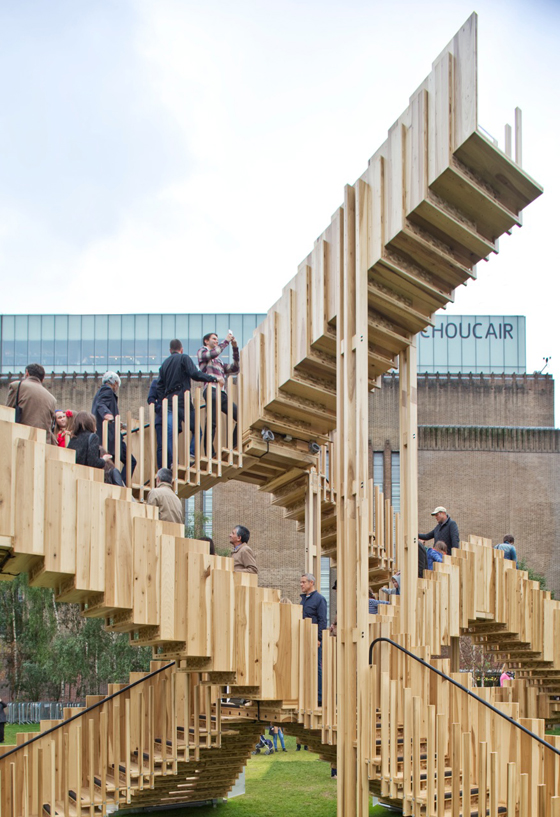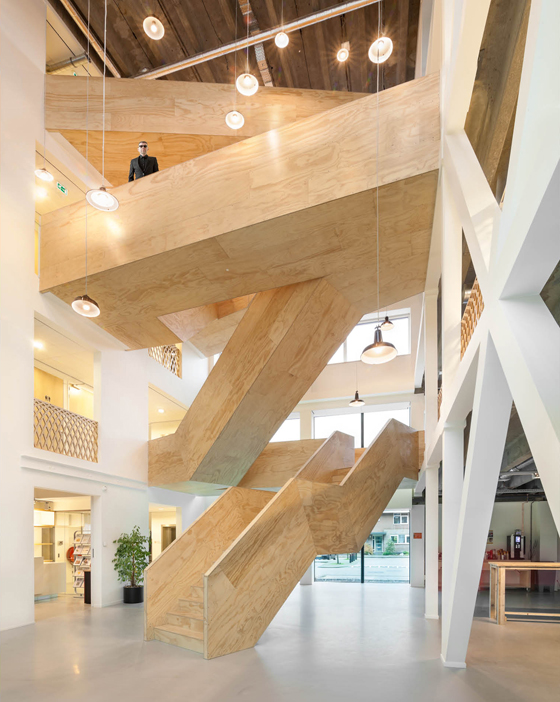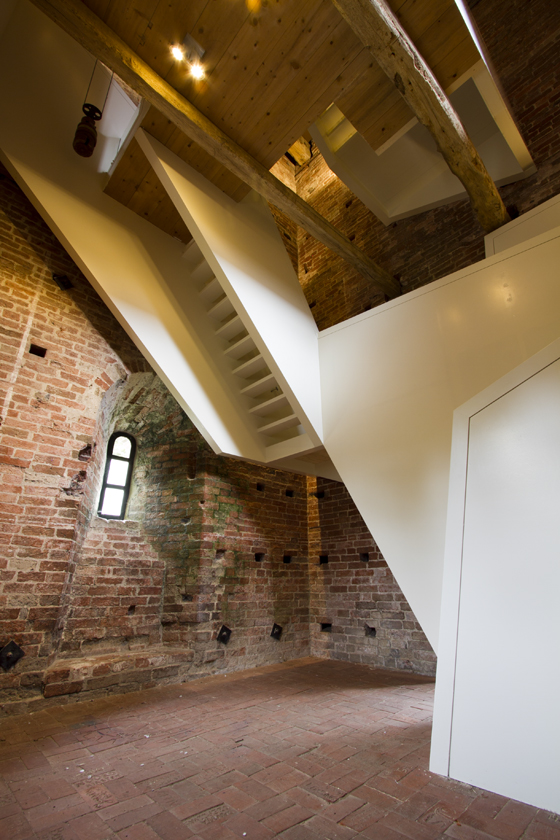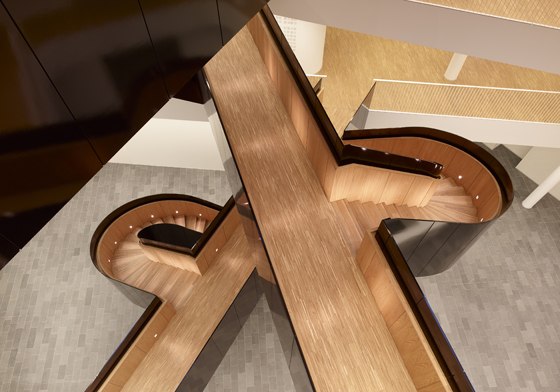Architecture in Ascendance: innovative staircase design
Texte par Dominic Lutyens
London, Royaume-Uni
15.12.13
Staircases are overdetermined things. A highly functional element in the internal circulation of a building, they are also laden with cultural and psychological symbolism. We may live in the age of the lift and escalator, but this hasn’t stopped architects using the staircase as a means of adding value to spaces, be it through their aesthetic or engineering virtuosity. It’s not the destination that counts but the getting there.
The eye-catching, high-gloss staircase at UN City, the UN’s new regional HQ in Copenhagen, inspires employees to use the stairs and have informal meetings; photo Adam Mørk courtesy of 3XN
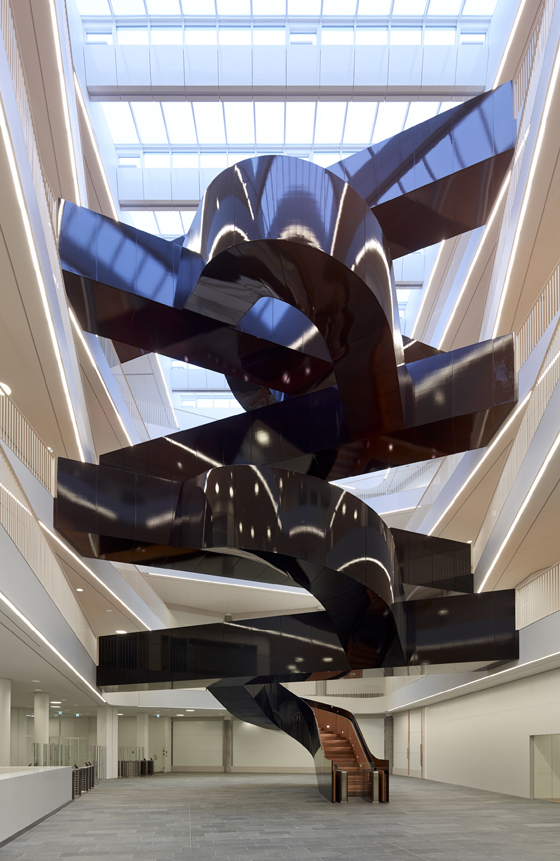
The eye-catching, high-gloss staircase at UN City, the UN’s new regional HQ in Copenhagen, inspires employees to use the stairs and have informal meetings; photo Adam Mørk courtesy of 3XN
×Freighted with symbolism and mythological references, staircases have long fascinated artists, architects, film directors, and even psychoanalysts. Yet they have been viewed with ambivalence. In The Book of Genesis, the Tower of Babel symbolises hubris resulting from the human arrogance of attempting to reach heaven, yet Jacob’s Ladder represents a glorious pathway to it. ‘Steps that lead down towards death… have given rise to striking images, a baby in a perambulator hurtling down the Odessa Steps in Battleship Potemkin… the dizzying staircase in Hitchock’s Vertigo,’ writes architect Oscar Tusquets Blanca in the introduction to a new book ‘The Staircase – The Architecture of Ascent’ (Thames & Hudson), a history of staircases culminating in 21st-century examples by architects IM Pei and Mario Botta.
Launched at the last London Design Festival, the surreal Endless Stair, designed by London-based architects drMM, has the potential to be re-erected in other cities; photos Jonas Lencer (top) and Judith Stichtenoth (above)
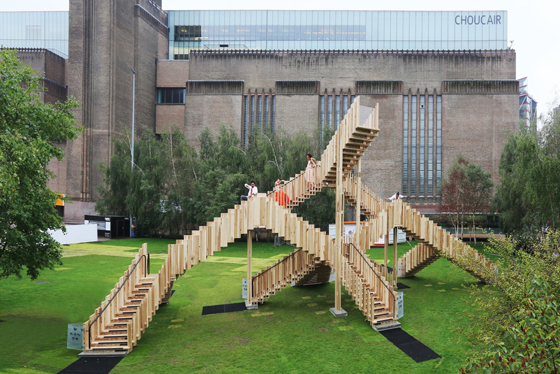
Launched at the last London Design Festival, the surreal Endless Stair, designed by London-based architects drMM, has the potential to be re-erected in other cities; photos Jonas Lencer (top) and Judith Stichtenoth (above)
×Potentially infinite and lacking a clear destination, staircases have also connoted futility. In 18th-century artist Giovanni Piranesi’s nightmarish prints of prisons, human figures are dwarfed by gargantuan staircases, while MC Escher depicted human automatons locked in an endless, pointless ascent and descent of stairs. By contrast, Sigmund Freud, interpreted dreams of stairs as meaning sexual intercourse. And stairways have appealed for their theatrical potential, too. In the movie Gold Diggers of 1933, sweeping staircases were employed to heighten the glamour of Busby Berkeley’s lavish choreography.
Multifunctional, auditorium-style steps in New York’s co-working space Neuehouse, designed by Rockwell Group, are used for meetings, lectures and concerts; photos Eric Laignel
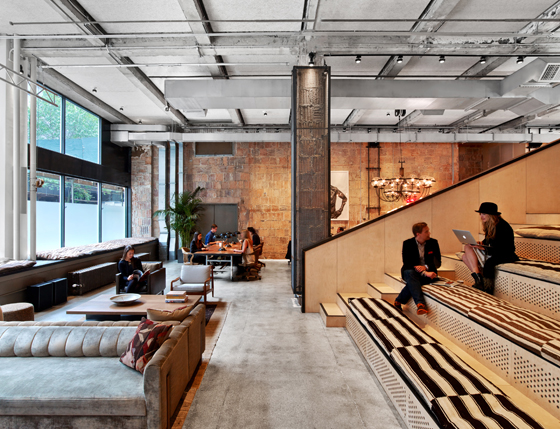
Multifunctional, auditorium-style steps in New York’s co-working space Neuehouse, designed by Rockwell Group, are used for meetings, lectures and concerts; photos Eric Laignel
×Today, experimentation with staircases is very much in the air, with architects sometimes capitalising on their sculptural potential at the expense of functionality. Perhaps this is because some architects, including Tusquets Blanca, lament the fact that high-speed lifts are threatening to usurp stairs, and as such view the seemingly endangered staircase in a romantic light. A highlight of the recent London Design Festival was Endless Stair – 15 interlocking staircases designed by architects De Rijke Marsh Morgan (drMM) and engineered by Arup, in association with the American Hardwood Export Council. Alex de Rijke of drMM described the structure, erected in front of Tate Modern, as an ‘Escher-like game of perception and circulation in timber’. Effectively leading nowhere, these paradoxical, surreal stairs served one unexpected function: they led to a viewing platform overlooking Tate Modern and the Thames.
These stairs in the office of data storage firm Evernote in California, designed by architects O + A, are part of a growing trend for dual-functional staircases
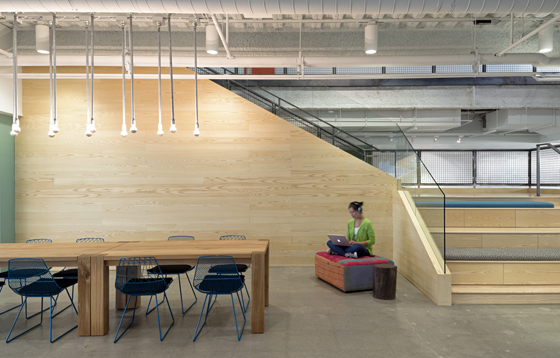
These stairs in the office of data storage firm Evernote in California, designed by architects O + A, are part of a growing trend for dual-functional staircases
×For de Rijke, stairways appeal for being sculptural and, in theory, social, two ideas other cutting-edge architects are also exploring: ‘On stairs people interact… they’re interesting places with social potential. We thought a staircase would be a good vehicle for… making a sculpture. Stairs are sculpture’s gift to architecture.’ Made of cross-laminated panels of tulipwood, a sustainable hardwood, Endless Stair is also highly stable since its pyramidal structures transfer all the weight on it to the ground.
Studioninedots conceived this staircase at mixed-use building De Burgemeester in the Netherlands as a ‘vertical lobby’ that brings people together; photos Peter Cuypers
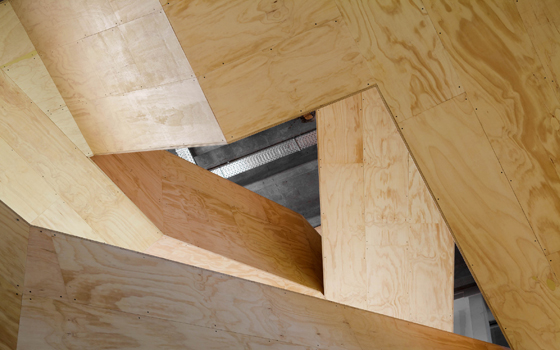
Studioninedots conceived this staircase at mixed-use building De Burgemeester in the Netherlands as a ‘vertical lobby’ that brings people together; photos Peter Cuypers
×Stairs are also treated as social space at Neuehouse, a members-only, co-working space for creatives in New York, which once housed a lighting manufacturing firm. Redesigned by Rockwell Group, its ground floor is dominated by its so-called ‘Spanish Steps’, conceived as seating rather than a conventional staircase. ‘They’re used during the day as an informal meeting/ workspace,’ explains Neuehouse’s main architect Greg Keffer. ‘There’s a stage across from them and at night they’re transformed into “stadium seating” for lectures and concerts. The steps are part of a larger, elongated structure based on a pier which cuts the ground floor in half, allowing us to organise it into smaller, more intimate work and lounging areas.’
Rick Mather Architects’ radical redesign of the Ashmolean Museum in Oxford nevertheless has a light touch, exemplified by its ethereal, glass-balustraded staircase; photo Andy Matthews
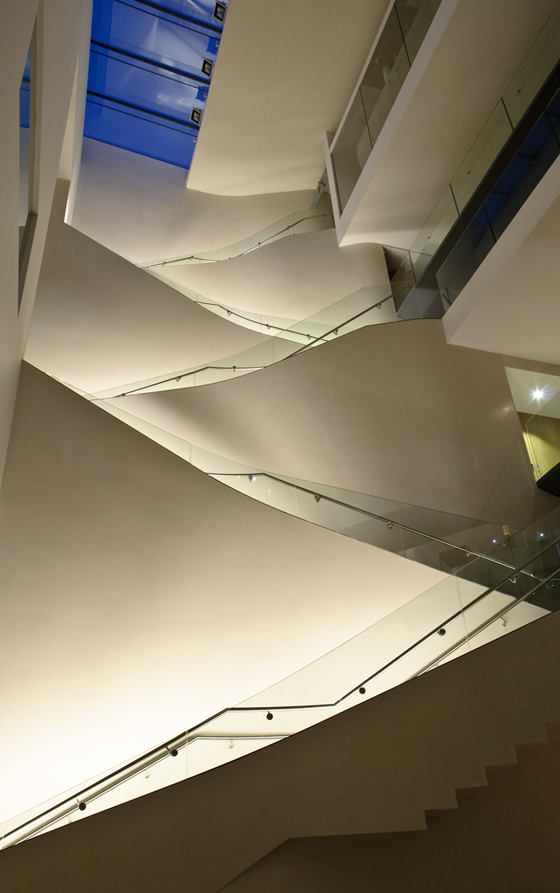
Rick Mather Architects’ radical redesign of the Ashmolean Museum in Oxford nevertheless has a light touch, exemplified by its ethereal, glass-balustraded staircase; photo Andy Matthews
×And San Francisco-based architects O + A have designed a dual-functional, ash stairway connecting the fourth and fifth floors in the office of data-storage company Evernote in Redwood City, California. This is split in two: on one side is a staircase, on the other upholstered, wide ‘stairs’ that employees can perch on and chat. Also boasting a large communal dining room and coffee counters aplenty, this interior embodies the belief that an informally designed environment stimulates creativity.
This staircase by Dutch architects Onix in the medieval Uitwierde Tower is designed to give visitors different perspectives of its interior as they climb it; photos Peter van der Knoop
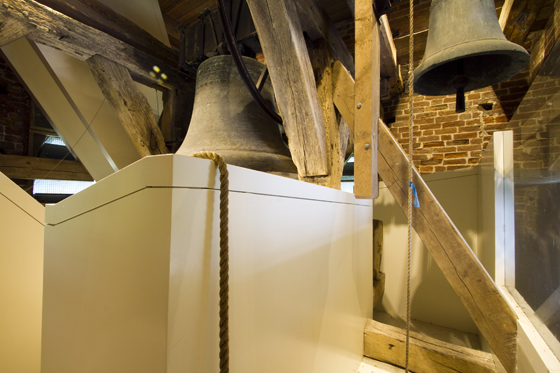
This staircase by Dutch architects Onix in the medieval Uitwierde Tower is designed to give visitors different perspectives of its interior as they climb it; photos Peter van der Knoop
×In a mixed-use building called De Burgemeester in Hoofddorp in the Netherlands – a former office recently redesigned by Dutch practice Studioninedots – a new plywood-clad staircase with broad stairs that criss-crosses a huge atrium is intended to inspire spontaneous social interaction between its offices’ employees. ‘The staircase lends the building a collective identity,’ say its architects.
Encouraging interaction between its staff, UN City’s staircase echoes the UN’s broader commitment to international dialogue; photos Adam Mørk courtesy of 3XN

Encouraging interaction between its staff, UN City’s staircase echoes the UN’s broader commitment to international dialogue; photos Adam Mørk courtesy of 3XN
×Equally sculptural but more spectacular still is the staircase at Danish architects 3XN’s new building UN City, the UN’s regional HQ on an artificial island in Copenhagen’s docks. UN City is star-shaped, expressing the UN’s desire to reach all parts of the world, while its daylight-flooded atrium features a complex, wide staircase strikingly encased in black, expressly designed to spark interaction and informal meetings between employees.
A spiral staircase with Art Deco overtones is the flamboyant focal point of Caruso St John’s recent renovation of part of Tate Britain; photos Hélène Binet
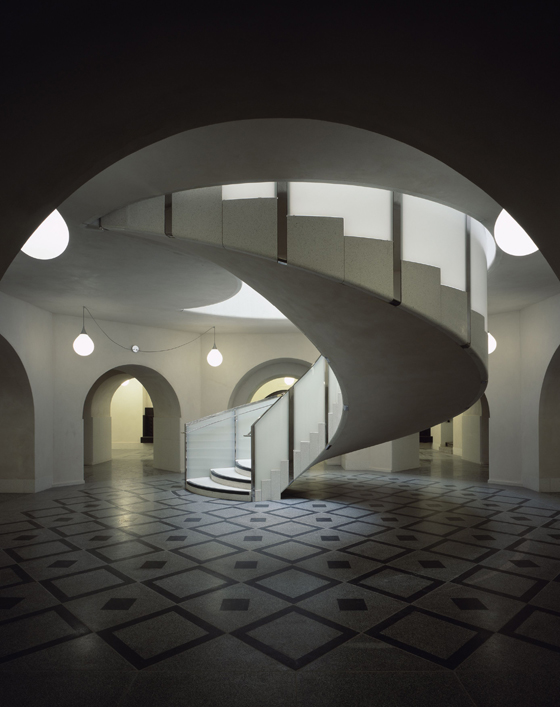
A spiral staircase with Art Deco overtones is the flamboyant focal point of Caruso St John’s recent renovation of part of Tate Britain; photos Hélène Binet
×Meanwhile, a new staircase in the 13th-century Uitwierde Tower in a rural area of the Netherlands, designed by Onix, has both a sculptural impact – its starkly modernist structure contrasts with the ancient bricks and beams in the tower’s interior, now open to the public for the first time – and fulfils an educational function. The banister changes height as it ascends, exposing different views of the tower, while information boards recount its history. At its apex, the staircase juts surreally out of a window at the top of the belltower and morphs into a balcony affording views of the surrounding countryside.
This boxy, wooden staircase twists up the interior of furniture retail outlet Design Collective near Shanghai, designed by Neri & Hu, offering visitors intriguing, contrasting views; photo Shen Zhonghai
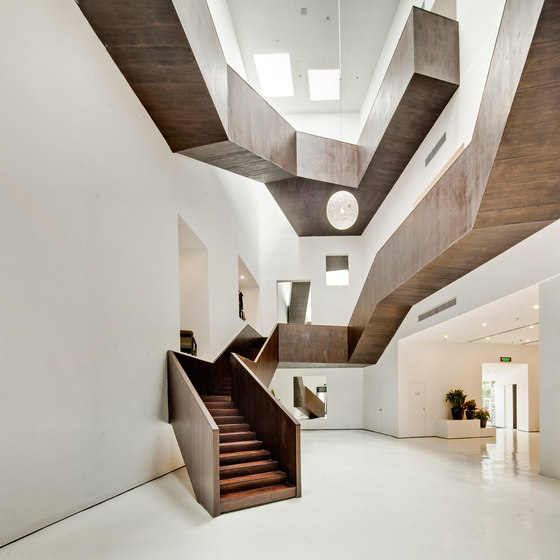
This boxy, wooden staircase twists up the interior of furniture retail outlet Design Collective near Shanghai, designed by Neri & Hu, offering visitors intriguing, contrasting views; photo Shen Zhonghai
×A more classical, spiral staircase forms part of architects Caruso St John’s £45m redesign of the oldest part of London’s Tate Britain, unveiled in November. This bold, monochrome staircase under an ornate rotunda descends to a newly expanded basement boasting the revamped Rex Whistler Restaurant and education rooms. Encircling the stairs on the first floor is a balcony with a new members’ café. The staircase makes historical references – its elegant, black and white scallop motifs evoke Art Deco – yet looks contemporary. In fact, Caruso St John is known for its refurbishments of old buildings, including its contemporary front extension to London’s Museum of Childhood, and for fusing classical architecture with a clean-lined aesthetic.
An ornate staircase connects the ground and second floors in WOHA’s glamorous hotel-cum-office, Parkroyal on Pickering, in Singapore; photo Patrick Bingham-Hall
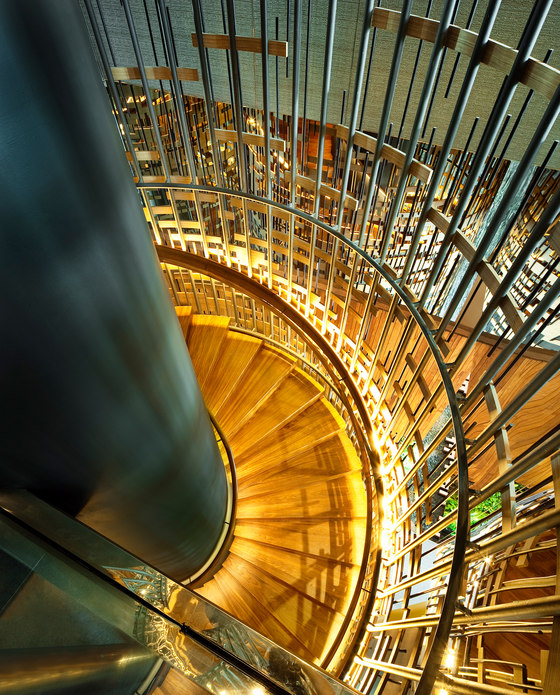
An ornate staircase connects the ground and second floors in WOHA’s glamorous hotel-cum-office, Parkroyal on Pickering, in Singapore; photo Patrick Bingham-Hall
×The renovation of another venerable institution, the Ashmolean Museum in Oxford – undertaken in 2009 by London’s Rick Mather Architects – bucks the trend for imposing, sculptural staircases. The museum was previously claustrophobic, gloomy and forbidding, and the radical yet understated redesign now includes a spacious atrium, while the exhibits have been redistributed around galleries on five floors reached by an ethereal, glass-balustraded staircase and walkways. Here, the semi-transparent staircase symbolises a desire to render culture accessible, rather than intimidating.
For architects, staircases have an eternal appeal – not just as humdrum routes up or down but as a vehicle for conveying the character of the spaces they grace.
...

